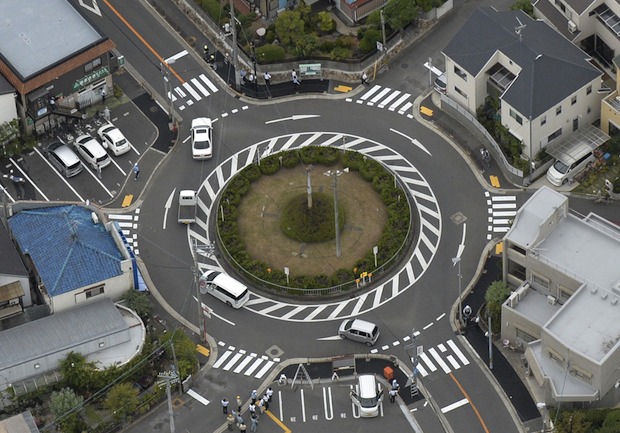People from Britain, like myself, often forget that many other countries don’t have roundabouts. The idea of a circular junction with no traffic lights, where the unspoken rules of the road define who gives way and who pulls out and when — this frankly baffles non-Britons when they first witness the workings of one of the nation’s iconic roundabouts.
While standardized and made famous in the UK during the 1990’s, there are roundabouts today in places as far apart as Qatar, New Zealand, China and France. And now Japan.
There has been some speculation about Japan introducing signal-less roundabouts in the past but they’ve finally done it. There are 15 operating in 7 prefectures around Japan, as of September 1st. There are actually around 140 circular intersections in Japan, with some of these now legally designated as roundabouts.

In 2012 six unsignalized intersections were tested in Karuizawa, Nagano, and then further tests were carried out in Shizuoka and Shiga prefectures.
Motorists in Japan, with its danger of electrical blackouts from the frequent earthquakes and other natural disasters, are actually possibly safer off with roundabouts, as they can be used without power. Roundabouts are not only better for the environment, they are also said to reduce accidents.
And if the idea of giving way to oncoming motorists without a signal to tell you to stop sounds like a recipe for traffic mayhem, remember that the Japanese a polite bunch. We predict the roundabout will be a success in this land of small cars and good manners.






















1 Comment
It’s good to see that modern roundabouts are coming to Japan at last. While it’s true that Japan has been particularly resistant to the idea in the past, I think you’re greatly underestimating the extent to which the rest of the world now uses roundabouts. I can’t think of a single European country that doesn’t have roundabouts — France alone had over 30,000 as long ago as 2008 (half of all those in the world, although the UK has more per route-kilometre). There are currently about 2,000 in the USA and their number is growing fast, though they still have some way to go before they catch up with another big country, Australia, where there are at least 5,000 in the city of Melbourne alone. The history of the modern roundabout goes back rather longer than you imply, too. The offside priority rule (which is what distinguishes a roundabout from just any old circular intersection) was devised in the UK in the early 1960s, and became mandatory in 1966. 15 roundabouts in the whole of Japan as of September 2014 is a start, however! And I’ve read that it was planned to open another 34 by the end of the year. Good luck! (A survey in areas of the US yet to experience roundabouts found 68% opposed to the idea in 1998; nine years later, following their introduction, up to 87% of respondents were in favour.)